The protests and roadblocks by demonstrators demanding the resignation of the president of Peru, Dina Boluarte, continue this Friday in most of the country's departments, especially in the south, where access by train was also blocked. to Machu Picchu.
The social outbreak that began on December 7 after Pedro Castillo's failed self-coup and his subsequent arrest has raised pressure against the government, but the president and her cabinet have chosen to entrench themselves.
The hypothesis of exploring a dialogue between the authorities and the protesters is not yet on the table.
Boluarte accused those who participated in the first march that sought to reach the center of Lima on Thursday of trying to "generate chaos to seize power."
The violent confrontations that took place in some neighborhoods in the capital continue this Friday in several provinces of the interior, from Arequipa to Puno.
That is where the greatest police repression has taken place and where another young man died, number 55 since the crisis began.
The police deployment of almost 12,000 troops prevented the civil organizations of the mountains that are the backbone of the protest from reaching Congress and the Government Palace, but it did not stop the wave of indignation that runs through the Andean country.
The security forces had the mission of lessening the impact of the so-called Great March of the Four Theirs, thus named in reference to the mobilization that put an end to the Alberto Fujimori regime.
The big question was whether the people of Lima would join in en masse, which they did to some extent the day before the march.
Students from the capital's main public universities, such as the Universidad Nacional Mayor de San Marcos (UNMSM) and the Universidad Nacional de Ingeniería (UNI), had reached out to the protesters, offering shelter and donations.
Thousands of people began to parade at four in the afternoon at various points in the capital.
The police siege and the protesters' lack of organization meant that the call fell far short of its goal of getting closer to the heart of Lima's political power.
There were police charges in Abancay, a strategic avenue that leads to the seat of the legislative power.
There were no deaths, although some injuries were reported.
Unlike the regions of the southern highlands, in the capital the police did not use firearms and the strategy to control the mobilizations was not the same as on previous occasions.
At dusk, the Plaza San Martín in the center of Lima seemed a favorable setting for the protest.
It was at that precise moment when an old house in one of the corners of the square began to burn.
In the midst of the confusion, the police regained ground, once again encircling the plaza.
As the fire consumed the building, the march was consumed.
And the demonstrators ended up dispersing.
More than five pumpers and three water tankers were needed to control the fire.
A group of neighbours, who did not identify themselves, pointed out that the incident was caused by a tear gas bomb that fell on the roof, although the Government denies it.
While the flames from the building dyed the sky of the Peruvian capital red, President Dina Boluarte gave a message to the nation, in which, far from empathizing with a large group of citizens who marched in the streets, she repudiated the protest by labeling to the protesters of "bad citizens who seek to break the rule of law."
She assured that "the government is firm" and her cabinet "more united than ever."
Meanwhile, in the south, a citizen died who had been seriously injured the day before by the impact of a firearm.
This was the second victim in Macusani, Carabaya province, where a group of residents set fire to a police station and the headquarters of the Judiciary on Wednesday night.
But it was not the only incident in the region that borders Bolivia.
Again,
the inhabitants tried to take over the Inca Manco Cápac airport and confronted the police.
The result: seven civilians and two officers injured.
In Arequipa, the seizure added the 55th victim of the conflict.
Jhancarlo Condori Arcana, a 30-year-old man who received a lethal wound to the abdomen.
In the White City, the demonstrators also tried to force their way into the Alfredo Rodríguez Ballón airport, but were unsuccessful.
The Executive declared the regions of Amazonas, La Libertad and Tacna in a state of emergency for 30 days.
After this first big march in the capital, the protesters will remain in the streets.
Follow all the international information on
and
, or in
our weekly newsletter
.

/cloudfront-eu-central-1.images.arcpublishing.com/prisa/OBHAKMOQMX732SIAD5EX47JRCA.jpg)







